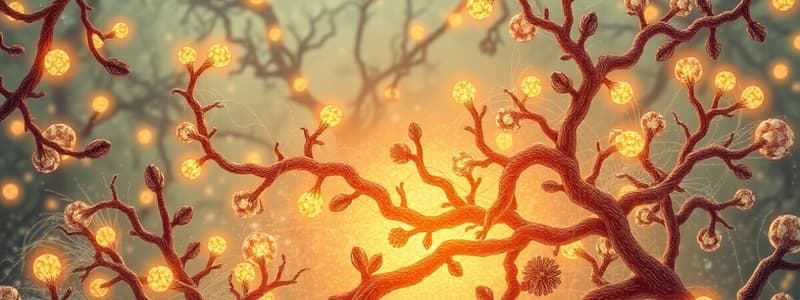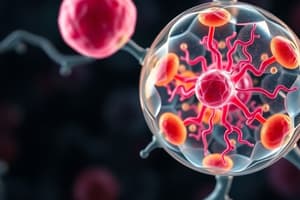Podcast
Questions and Answers
Which of the following best describes the role of ATP in a cell?
Which of the following best describes the role of ATP in a cell?
- It is a storage molecule for genetic information.
- It is a high-energy molecule used to do work. (correct)
- It is a structural component of the cell membrane.
- It is an enzyme that catalyzes metabolic reactions.
Photosynthesis and cellular respiration are unrelated processes that occur independently in cells.
Photosynthesis and cellular respiration are unrelated processes that occur independently in cells.
False (B)
What are the two main types of energy?
What are the two main types of energy?
kinetic and potential
The process of making glucose using carbon dioxide, water, and light energy is called ________.
The process of making glucose using carbon dioxide, water, and light energy is called ________.
Match the following components with their roles in photosynthesis:
Match the following components with their roles in photosynthesis:
During cellular respiration, what is the primary role of oxygen?
During cellular respiration, what is the primary role of oxygen?
The Calvin cycle occurs in the thylakoid membranes of the chloroplast.
The Calvin cycle occurs in the thylakoid membranes of the chloroplast.
What is the main product of the light reactions in photosynthesis?
What is the main product of the light reactions in photosynthesis?
Glycolysis occurs in the ________ of the cell.
Glycolysis occurs in the ________ of the cell.
Match the following steps of cellular respiration with their location:
Match the following steps of cellular respiration with their location:
Which of the following equations correctly represents photosynthesis?
Which of the following equations correctly represents photosynthesis?
ATP is composed of adenine, ribose, and two phosphate groups.
ATP is composed of adenine, ribose, and two phosphate groups.
What is the role of chlorophyll in photosynthesis?
What is the role of chlorophyll in photosynthesis?
The final electron acceptor in the electron transport chain is ________.
The final electron acceptor in the electron transport chain is ________.
Match the following terms with their descriptions:
Match the following terms with their descriptions:
Which of the following best describes the ATP cycle?
Which of the following best describes the ATP cycle?
Only plants and algae can perform cellular respiration
Only plants and algae can perform cellular respiration
Besides ATP and Hydrogen ions, what is other product of the light reactions?
Besides ATP and Hydrogen ions, what is other product of the light reactions?
The 'gel' that fills up the chloroplasts is called the ________.
The 'gel' that fills up the chloroplasts is called the ________.
Match the reactants and products of Photosynthesis and Cell Respiration with their equations:
Match the reactants and products of Photosynthesis and Cell Respiration with their equations:
Flashcards
Chloroplasts and Mitochondria
Chloroplasts and Mitochondria
Organelles that convert energy from one form to another; chloroplasts are for photosynthesis, mitochondria for cell respiration.
Energy
Energy
The ability to do work, existing in two main forms: kinetic (motion) and potential (stored).
Kinetic Energy
Kinetic Energy
Energy of motion. Light is an example.
Potential Energy
Potential Energy
Signup and view all the flashcards
ATP
ATP
Signup and view all the flashcards
ADP
ADP
Signup and view all the flashcards
ATP Cycle
ATP Cycle
Signup and view all the flashcards
Photosynthesis Equation
Photosynthesis Equation
Signup and view all the flashcards
Cell Respiration Equation
Cell Respiration Equation
Signup and view all the flashcards
Relationship Between Photosynthesis and Cell Respiration
Relationship Between Photosynthesis and Cell Respiration
Signup and view all the flashcards
Photosynthesis
Photosynthesis
Signup and view all the flashcards
Thylakoid Membranes
Thylakoid Membranes
Signup and view all the flashcards
Stroma
Stroma
Signup and view all the flashcards
Light Reactions
Light Reactions
Signup and view all the flashcards
Calvin Cycle
Calvin Cycle
Signup and view all the flashcards
Sodium Bicarbonate in Photosynthesis Lab
Sodium Bicarbonate in Photosynthesis Lab
Signup and view all the flashcards
Floating Leaves in Photosynthesis Lab
Floating Leaves in Photosynthesis Lab
Signup and view all the flashcards
Aerobic Cell Respiration Equation
Aerobic Cell Respiration Equation
Signup and view all the flashcards
Glycolysis
Glycolysis
Signup and view all the flashcards
Krebs Cycle
Krebs Cycle
Signup and view all the flashcards
Study Notes
- Chloroplasts and mitochondria are cell organelles for energy conversion.
- Chloroplasts are the site of photosynthesis.
- Mitochondria are the site of cell respiration.
Energy
- Energy is the ability to do work.
- Kinetic energy is the energy of motion.
- Potential energy is stored energy.
- Light is a type of kinetic energy that travels in waves.
- Chemical energy is a type of potential energy stored in chemical bonds of food molecules like carbohydrates, lipids, and proteins.
- Cells use ATP for all work.
- ATP is a high-energy molecule comprised of a nitrogen base (adenine), sugar (ribose), and 3 phosphates.
- ADP is like a "dead battery" and contains adenine, ribose, and 2 phosphates.
- ATP releases energy by breaking off one phosphate, becoming ADP.
- ADP can be "recharged" to ATP by adding energy from glucose and one phosphate.
Photosynthesis and Cell Respiration
- Photosynthesis and cell respiration are chemical reactions converting energy.
- Photosynthesis equation: CO2 + H2O + light energy → C6H12O6 + O2
- Cell respiration equation: C6H12O6 + O2 → CO2 + H2O + ATP energy
- Photosynthesis reactants are the products of cell respiration.
- Cell respiration reactants are the products of photosynthesis.
Photosynthesis
- Photosynthesis makes glucose using carbon dioxide, water, and light energy in chloroplasts.
- Only plants and algae perform photosynthesis.
- Chloroplasts contain chlorophyll, a green pigment that absorbs light energy.
- Chloroplasts have a double-layered outer membrane.
- Thylakoid membranes are pancake-shaped with chlorophyll.
- Stroma is the gel-like substance filling chloroplasts.
- Photosynthesis equation: CO2 + H2O + sunlight → C6H12O6 + O2
Steps of Photosynthesis
- Light reactions occur on thylakoid membranes using water and light to produce oxygen, ATP, and H ions.
- Calvin cycle happens in the stroma, combining carbon dioxide, ATP, and H ions to produce glucose.
- In the photosynthesis lab, sodium bicarbonate provided CO2.
- Oxygen production causes leaves to float, indicating the rate of photosynthesis.
Cellular Respiration
- Aerobic cell respiration equation: C6H12O6 + O2 → CO2 + H2O + 36 ATP
Steps of Aerobic Cell Respiration
- Glycolysis occurs in the cytoplasm, converting glucose into 2 pyruvate + 2 ATP.
- Krebs Cycle occurs in the mitochondrial matrix, turning pyruvate into CO2, H ions, electrons and 2 ATP.
- Electron Transport Chain (ETC) occurs on the mitochondrial cristae, using oxygen, H ions, and electrons to produce water and 32 ATP.
Studying That Suits You
Use AI to generate personalized quizzes and flashcards to suit your learning preferences.




